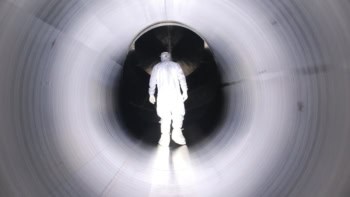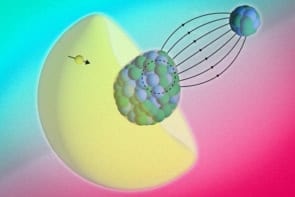Short films to get you ready for the switch-on of the Large Hadron Collider

So what is the site about?
Colliding Particles is a series of short films chronicling what it is like to be a physicist at CERN’s Large Hadron Collider (LHC). Each instalment of the series focuses on a different aspect of life as a full-time Higgs-hunter, while also (loosely) following the progress of a single team of researchers. The first episode was filmed before the LHC’s gala launch on 10 September 2008, and it introduces a few basic ideas about the collider and the Higgs boson. Later episodes explore the media hype on “Big Bang Day”, scientific conferences, problems with the collider and why the LHC is worth its multibillion-Euro price tag.
Who is involved?
The main people in the films are members of “Project Eurostar”, a group of researchers working on a new technique for finding the Higgs using ATLAS, one of the LHC’s two main all-purpose detectors. The group’s name derives from its origins as an informal collaboration – facilitated by the Eurostar rail link – between London-based experimentalist Jon Butterworth and Paris-based theorist Gavin Salam. Butterworth’s PhD student Adam Davison makes fun of the name on camera, but it seems to have stuck. The site itself is supported by the UK Science and Technology Facilities Council’s “Science in Society” programme, with films produced by documentary filmmaker Mike Paterson.
Who is it aimed at?
Although CERN researchers will undoubtedly get a kick out of spotting their colleagues in the background, students interested in science are the site’s main audience. Such students will benefit from seeing how science really works – including the disappointing/boring/frustrating bits – and there are some teaching resources available on the site to help them. Unfortunately, the films contain relatively little physics, so anyone who wants more than a cocktail-party-level understanding of the Higgs, the LHC or Project Eurostar itself will need to dig into the site’s “further reading” section.
Why should I visit?
As Physics World readers know, the LHC is due to restart later this month, following a long shutdown that began just nine days after its initial switch-on in 2008. Oddly enough, this delay – while terrible for CERN’s would-be particle colliders – has been good for Colliding Particles. Recent episodes on the LHC’s breakdown and science funding are far more insightful than previous ones filmed in its heady early days. In one scene in the “Collidonomics” episode, for example, Eurostar’s Butterworth is at a funding review. As a researcher in the background talks dispiritedly about the rising cost of liquid helium, he manages a wry grin. Life as an academic, he says, “sure as hell doesn’t feel like an ivory tower when you have to stand up and defend yourself” from budget cuts. This is something all physicists can appreciate – and that any would-be physics students should see.
What are some highlights?
In one segment of the “Problems” episode, several researchers struggle to explain what caused the LHC to be shut down last autumn – without using the phrase “blew up”, which is apparently off limits. “Engineering breakdown”, “technical malfunction” and “catastrophic release of liquid helium – wait, scratch the ‘catastrophic’ bit” are some of the euphemisms they offer; but amid the silliness, their explanations are sound and easy to follow. At the end of the same episode, Salam, the Eurostar theorist, suggests that the universe is like a piece of music. With the lower-energy collisions at Fermilab’s Tevatron, he says, we could hear the double basses, but the LHC will add the cellos – and from there, we will begin to figure out what the rest of the orchestra is playing. In a field full of analogies, most of them over-used, this one feels both fresh and insightful. But here’s hoping the next episodes in the series contain some new science, not just new metaphors.



